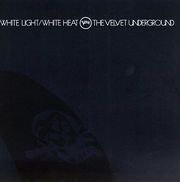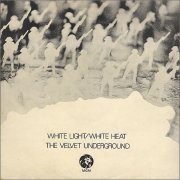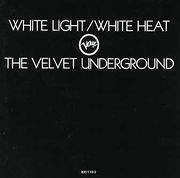White Light/White Heat
| White Light/White Heat | ||||
|---|---|---|---|---|
 |
||||
| Studio album by The Velvet Underground | ||||
| Released | January 30, 1968 | |||
| Recorded | September 1967, Scepter Studios, New York City, New York, United States | |||
| Genre | Experimental rock Protopunk Art rock Avant garde |
|||
| Length | 40:13 | |||
| Language | English | |||
| Label | Verve | |||
| Producer | Tom Wilson | |||
| Professional reviews | ||||
|
||||
| The Velvet Underground chronology | ||||
|
||||
| Alternate cover | ||||

Alternate UK cover (1976)
|
||||
| Alternate cover | ||||

Alternate cover (1985 remaster)
|
||||
| Singles from White Light/White Heat | ||||
|
||||
White Light/White Heat is the second studio album by the American rock band The Velvet Underground. The record was the group's last with violist and founding member John Cale.
Contents |
Recording
After the disappointing sales of The Velvet Underground's first album, The Velvet Underground & Nico, the band's relationship with Andy Warhol deteriorated. They toured throughout most of 1967. Many of their live performances featured noisy improvisations that would become key elements on White Light/White Heat.[1] The band eventually fired Warhol and parted ways with Nico;[2] and ultimately went on to record their second album with a new producer.
The album was recorded in just two days, and with a noticeably different style than The Velvet Underground & Nico. John Cale described White Light/White Heat as "a very rabid record...The first one had some gentility, some beauty. The second one was consciously anti-beauty." Sterling Morrison said, "We were all pulling in the same direction. We may have been dragging each other off a cliff, but we were all definitely going in the same direction. In the White Light/White Heat era, our lives were chaos. That’s what’s reflected in the record."
Reception
The album briefly appeared on the Billboard 200, although only peaking at number 199.[3] Despite its poor sales, the distorted, feedback-driven, and roughly recorded sound on White Light/White Heat became a notable influence on punk and experimental rock.[4] In 2003, the album was ranked number 292 on Rolling Stone magazine's list of the 500 greatest albums of all time.
Themes and composition
Nearly every song on the album contains some sort of experimental or avant-garde quality. "The Gift", for example, contains a recital of a short story and a loud instrumental rock song playing simultaneously, with the former on the left speaker channel and the latter on the right. "I Heard Her Call My Name" is distinguishable for its distorted guitar solos and prominent use of feedback.
The record's lyrics vary from themes of drug use and sexual references (such as fellatio and orgies), including the song "Lady Godiva's Operation", about a transsexual's botched lobotomy, and the title track "White Light/White Heat", which describes the use of amphetamine.
On the album's last track, "Sister Ray", Reed tells a tale of debauchery, while the band plays an improvised 17 minute jam around three chords.
Cover
The album cover to White Light/White Heat is a faint image of a tattoo of a skull. The picture of the tattooed arm was photographed, enlarged and distorted by Billy Name, one of the members of The Factory. It is difficult to distinguish the tattoo, as the image is black, printed on a slightly lighter black background. On this cover, the album name, the Verve logo, and the band name are all on one line.
An alternate cover was used for Polydor's mid-1980s reissues. This cover had a completely black background, without the arm in the background. On this version, the album name, Verve logo, and band name are printed on three separate lines.
There also exists a unique MGM UK cover, produced from 1976 until the early 1980s, featuring a white background and abstract toy soldiers.
Track listing
All tracks written by Lou Reed unless otherwise noted.
- Side one
- "White Light/White Heat" – 2:47
- "The Gift" (Reed, Morrison, Cale, Tucker) – 8:18
- "Lady Godiva's Operation" – 4:56
- "Here She Comes Now" (Reed, Morrison, Cale) – 2:04
- Side two
- "I Heard Her Call My Name" – 4:38
- "Sister Ray" (Reed, Morrison, Cale, Tucker) – 17:27
Personnel
- The Velvet Underground
- John Cale – vocals, electric viola, organ, bass guitar, Medical Sound Effects on Lady Godiva's Operation
- Sterling Morrison – vocals, guitar, bass guitar, Medical Sound Effects on Lady Godiva's Operation
- Lou Reed – vocals, guitar, piano
- Maureen Tucker – percussion, drums
- Production
- Gary Kellgren – recording engineer
- Bob Ludwig – mastering
- Val Valentin – director of engineering
- Tom Wilson – producer
References
- ↑ Velvet Underground History and Facts at Music Babylon
- ↑ Andy Warhol 1967 at Warholstars
- ↑ 292) White Light/White Heat, The RS 500 Greatest Albums of All Time at Rolling Stone
- ↑ White Light/White Heat at PopMatters
|
||||||||||||||||||||